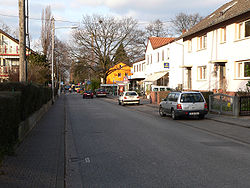Frankfurt-Goldstein
| Settlement in Frankfurt am Main | |
|---|---|
 Tannenkopfweg |
|
| Basic data | |
| Area : | 1.8 km² |
| Population : | 11,317 |
| Population density : | 6,287 inhabitants / km² |
| Creation time: | 1932 1962–1965 1971–1972 1981 (Goldstein-Süd) |
| location | |
| District : | 6 - West |
| District : | Schwanheim |
| District : | 53 2 (Goldstein-West) |
| architecture | |
| Architectural style: | |
| Urban planner: | Ernst May |
Coordinates: 50 ° 5 ' N , 8 ° 36' E
Goldstein is a settlement in the east of Frankfurt 's Schwanheim district with over 11,000 inhabitants. It derives its name from a moated castle built in 1348 or an old Frankfurt Hofgut.
The Goldstein estate
This formerly heavily fortified courtyard, located between Niederrad and Schwanheim, was the seat of an old local family in the 13th century, whose name it bore. The Goldstein, as it was called, had a twofold system of irrigated ditches that flowed into the Schwarzbach flowing south . The courtyard was accessible through a north-facing entrance via three drawbridges . An island formed by the Schwarzbach and the outer ditch was accessible via three wooden walkways. There was a fountain inside the courtyard and a newer one outside the courtyard north of the large drawbridge.
Johann and Gutgen Goldstein concluded in 1397 a " truce " with the city of Frankfurt, which lasted three years. In 1400 the farm was sold to Frankfurt. In 1552 it was burned down by Margrave Albrecht Alkibiades . On September 29, 1826, the city ceded the court to the Duchy of Nassau and received land near Niederrad. In 1840, Countess von Reichenbach-Lessonitz bought the farm. Her family sold the farm and the associated land to the city of Frankfurt in 1909.
The Goldstein settlement
The Goldstein settlement was the last of the suburban settlements planned by Frankfurt's head of settlement Ernst May , on fields that lay in the west of the city south of the Main in front of the Frankfurt city forest , around the old Goldstein estate. The site was already connected to the Frankfurt am Main tram network via the Unterschweinstiege Waldbahn stop . Planned in 1930, construction did not begin until 1932.
These were not typical workers' settlements , but mainly semi-detached houses were built on leasehold properties, which were initially intended for settler families with many children from the surrounding countryside. The land on which the houses stood was relatively large at 750 m² and should be used for vegetable gardens and the keeping of small livestock. The labor service of the NSDAP and the voluntary labor service were also involved in the construction. Above all, however, the future settlers had to help with the construction: each received a loan from the German Reich and, at a relatively low purchase price, had to work 2,700 and later 4,500 hours a year for the joint venture. With a 40-hour week this corresponds to a workload of approx. 60 to 120 weeks. From this it becomes clear that the planning took into account the very high unemployment at the time. Those who worked received food allowances. In the period from 1931 to 1933 all settlers were unemployed and not a single one had a job. After the seizure of power , the district personnel office of the NSDAP took the settlement under its own control, in 1936 there were almost no unemployed settlers. For a long time, the selection of the numerous applications for the houses took place from a political point of view. Before the Second World War , the settlement had become a National Socialist stronghold. When many apartments in Frankfurt were destroyed after the World War and apartment management took place, the administration responsible now ensured a mix of party politics. In the elections, Social Democrats in Goldstein achieved a high proportion of votes.
By 1936 320 small settlements were created. In the early days, the simply built houses had an outhouse in the garden, with no gas, water or sewer connections. Today the connections by the city of Frankfurt have long been established, but the old open drainage ditches, which the settlers jointly dug, are still there. In 1950 the Goldstein sewage treatment plant was built, which first took up the wastewater from the American settlement at Frankfurt Airport and later that of the Goldstein settlement. The Goldstein School was founded in 1952 .
From 1965, the first high-rise buildings in the so-called Niederrad office district were built in the still undeveloped eastern part of Goldstein (east of the A5) . At the same time the thermal power station was built. In 1972 the Italian company Olivetti moved into its office building , which was built by Egon Eiermann and is still striking today.
In the years from 1979 to 1996, the areas south of Straßburger Straße were gradually built on with apartment buildings, the Goldstein Süd sub-settlement led to a further increase in Schwanheim's population.
Individual evidence
Web links
- Goldsteinpark at par.frankfurt.de , the former website of the city of Frankfurt am Main
